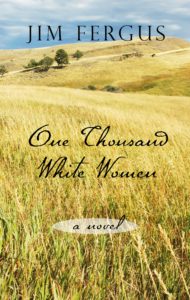One Thousand White Women by Jim Fergus
 This book has languished on my shelf for years, and for some reason the other day I decided to give it a try…and got lost in it for days.
This book has languished on my shelf for years, and for some reason the other day I decided to give it a try…and got lost in it for days.
I didn’t just read this book — I inhabited it.
Published back in 1998 (which may be how long I’ve had it), One Thousand White Women is a fictional re-imagining of a true event. In the author’s note, Mr. Fergus writes that he came across an interesting historical record. In 1854 at a peace conference, a Cheyenne chief made a request to trade white women for horses. The Cheyennes astutely saw the future and were looking for a peaceful solution. The women would become brides and their children would allow easier assimilation into the white man’s society. The request was soundly rejected by the US government.
But, Mr. Fergus wondered, what if it did happen? What if the government agreed to this absurd proposal and sent white women to marry into the Cheyenne tribe? The result is this wonderful and devastating book.
The novel imagines that the government recruited women volunteers from brothels and institutions under a so-called BFI (Brides for Indians) program to “assimilate the heathens”. One Thousand White Women centers on May Dodd whose story is told through her journals and letters.
May Dodd comes from a prominent Chicago family. When she runs off with a common laborer and has two children out of wedlock, her influential father has her committed to an insane asylum and has taken her children away to educate properly. With nothing left to lose, May volunteers for the program:
Frankly, from the way I have been treated by the so-called civilized people in my life, I rather look forward to residency among the savages.
And so we’re off with the first trainload of white women bound for the Great Plains and their new lives as brides of the Cheyenne nation. On the train are a troupe of vulnerable women and these supporting characters start out predictably stereotypical. We have Irish twins out to scam everyone, a fallen Southern belle (who hates blacks and uses the N word), a large homely Swiss woman — well the list goes on. I must admit, here the writing became clunky. But as the novel goes on, we learn each woman has their own reasons to want to start new lives. During their long journey the women get to know each other, reveal their various sad backgrounds, and as Fort Laramie draws closer, they grow more frightened and are drawn closer.
Eventually, they reach Fort Laramie where they are told to take only what they can carry and continue their journey on horseback. Once they arrive at the Cheyenne camp, there are nowhere near 1,000 women, merely 40-50 total and the women question their decision.
So what is our position then — officially speaking? Are we nothing more than sacrificial lambs? An interesting, but unsuccessful political experiment? Missionaries stranded in the line of duty? Or perhaps easiest to explain, white women gone astray, taking up with savages of our own volition?
After they are left behind, the women inevitably have to adapt to the camp and its inhabitants. They are eventually paired off with Cheyenne men and wedding plans are made. May is pleased to marry the chief, Little Wolf, some of the other women are less fortunate. But all make the best of the situation.
And here is where I fell headlong into the wonderful descriptions of the challenges, beauty and even the drudgery of daily life with the Cheyenne. The wild landscape, hunting for game, bathing in ponds, cozy teepees, and the Cheyenne wedding ceremonies. But all is not idyllic, there are battles with other tribes, violent rapes (yes that’s plural), and the Cheyenne’s first experience with whisky (not good). Mr. Fergus has done some fine research on 19th century native American culture, and his writing shows both compassion and insight.
There’s a poignant turning point when, after six months, the women return with their husbands and tribe to visit Fort Laramie. Wearing deerskin dresses and many now pregnant, they are not welcomed but rather met with revulsion and horror by the residents. They now look, act, and smell like squaws and bear no resemblance to the white women they once were.
How strange to recall that six months ago we departed Fort Laramie as anxious white women entering the wilderness for the first time; and now, perhaps equally anxious, we leave as squaws returning home. I realized anew as we rode into the cold north wind on this morning that my own commitment had been forever sealed by the new heart that beats in my belly; that I could not have remained even if I so wished.
Some readers may have trouble with the plausibility of this story and many other reviewers found One Thousand White Women ludicrous. My only quibble was the modern day insights and actions that leaked into the journals and letters of what was supposed to be a typical 19th century woman. There were even some thoughts on global warming, which I doubt was on the minds of anyone living in the late 1800’s.
But still, I found One Thousand White Women captivating and completely different. I often forgot reality and the fact that I was reading a novel. I was living in a different world — in a different time. A stay-up-late adventure story filled with action, humor, romance, insight and beauty.
BookBarmy Warning: there is graphic sex and violence – this is not a book for the faint of heart or prude. Nonetheless, I’m passing it on to my mother – as she is neither.





